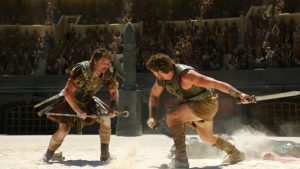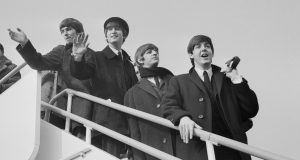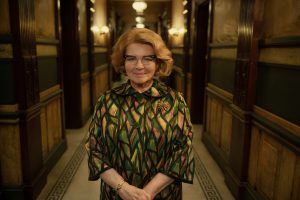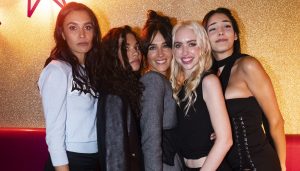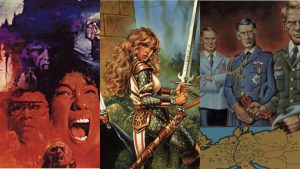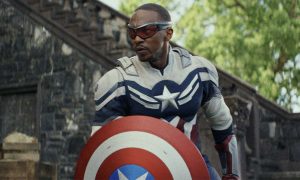
We can admit it now. The Marvels bombed.
Marvel has had some misfires before, but they usually happened only on the critical end. Audiences still rushed to see panned flicks like Ant-Man and the Wasp: Quantumania and Thor: Love & Thunder. But with The Marvels, audiences and critics came together to express their dissatisfaction. No one thing explains the problems. Like its predecessor Captain Marvel, bad faith reviews flooded the internet with people mad about lady superheroes, but numerous, and legitimate, other culprits led to the downfall: from superhero fatigue to a nonsense story combined with obnoxious editing, to separation from the larger shared universe.
In short, The Marvels comes at a key point in the MCU experiment, one whose failures and successes illuminate the way forward for the company. But rest assured, there is a way forward, and we have a few of our own silly ideas about how to navigate that.
Play With More Genres
In The Marvels’s most memorable scene, our trio of heroes goes to the planet Aldana where everyone communicates via song. Donning a goofy cap, Carol leads her companions through what plays like a musical number, complete with brightly colored costumes and sweeping camera movements. In the middle of the sequence, Carol transforms her costume into a gorgeous dress and takes the hand of Prince Yan (Park Seo-joon) like a proper Disney princess.
And then, just as quickly as it began, it ends.
The MCU has established itself as the McDonald’s of the cinematic world, a franchise that gives people exactly what they expect. Sure, certain films broke out of that mold to transcend into something universal and powerful, most obviously Black Panther. But most entries adhere to a house style that’s intended to keep even the lesser entries enjoyably familiar. However, the short musical bit in The Marvels proves that the MCU should consider more ambitiously handling other genres. The franchise has played with horror in Werewolf by Night and Doctor Strange in the Multiverse of Madness, and holiday settings with The Guardians of the Galaxy Holiday Special and Hawkeye. More importantly, WandaVision earned acclaim by invoking classic sitcom styles without ever leaving its central superhero structure.
The musical sequence in The Marvels stands out because it gestures to a different type of superhero movie than those we’ve seen before, a movie that keeps the costumes and powers but uses them to deal with unique problems in fresh ways.
Give the New Kids a Turn
Hands down, the best part of The Marvels is Iman Vellani as Kamala Khan. Even those who skipped out on the excellent Ms. Marvel series caught Vellani’s infectious energy. The entire world of the MCU felt refreshed and anew, so much so that she squealed at the sight of Nick Fury instead of rolling her eyes and praying that he doesn’t mention Secret Invasion.
Vellani is hardly the only new hero to capture fans’ hearts past Phase Three. Internet darling Florence Pugh turned in a delightful performance as Yelena Belova in Black Widow, alongside the always-great David Harbour as Red Guardian. Hailee Steinfeld proved she can be excellent playing two superheroes, embodying the spunky Kate Bishop on Hawkeye while portraying Gwen Stacy in Spider-Man: Across the Spider-Verse. Simu Liu brought Kung fu action to Shang-Chi and the Legend of the Ten Rings without losing the easy Marvel charm. And yet, most of these characters have appeared only on teaser posters, not in actual movies or shows.
The almost-post-credit scene of The Marvels teases more of these heroes in the future with Kamala recruiting Kate Bishop into a team that will presumably become the Young Avengers. But that only raises more frustration with all the characters teased in post-credits who have yet to appear, especially Brett Goldstein’s Hercules, Charlize Theron’s Clea, and Harry Styles’ Starfox. The X-Men nod at the end of The Marvels doesn’t help, partially because it exhumes the Fox X-Men once again, and also because Marvel has not announced any projects starring the mutants beyond the equally backward-looking Deadpool 3.
Bringing back Kamala Khan (and her family!) gave us more time to play with characters we know and like. The future for Marvel is bright with characters like her. If the MCU would only give them more screen time.
The Worse, the Better
To be clear, Zawe Ashton does her best with Dar-Benn, the Kree Accuser baddie of The Marvels. She glowers at the camera and stares at her enemies with wide-eyed madness. But that’s about all the characterization The Marvels is interested in giving Dar-Benn. The script doles out her backstory in such scattered fragments that we never see her as anything more than a one-note baddie, a person who likes evil for the evil of it all.
Dar-Benn harkens back to the first three phases of the MCU and not in a good way. Sure, we got Loki and Killmonger, and Ego the Living Planet, but we also got Malekith in Thor: The Dark World, Kaecilius in Doctor Strange, and Whiplash in Iron Man 2, characters who distracted from what we really enjoyed about those movies (more on that in a minute).
The best Marvel movies mix together compelling villains whose motivations and charisma challenge the heroes. Killmonger stands alongside Heath Ledger’s Joker as the best villain in any superhero movie because his mere presence forced T’Challa to reconsider his actions. Loki stole the spotlight from Thor and the Avengers because his arrogance and approach to power called into question the very idea of a superhero team. Yes, both of these characters are portrayed by charismatic performers, but the same is true of Dar-Benn, Kaecilius, and other wasted characters. Audiences are no longer accepting villains who serve as generic placeholders. Viewers deserve a better class of criminal, and if the MCU won’t give it to them, then they’ll get it someplace else.
The Real Marvels are the Friends We Made Along the Way
That said, the MCU isn’t really about the bad guys. The MCU became a global phenomenon not when Tony Stark said “I am Iron Man,” nor when Steve Rogers missed his dance to crash into the ice, and not even when the camera circled around Earth’s mightiest heroes as they assembled in The Avengers. Rather, it happened after the credits of The Avengers when the heroes sat around and ate shawarma. Still in costume, but too tired to look heroic—heck, too tired to toss off any Joss Whedon one-liners—the quintet simply sits around as friends.
That friendship between the characters and our affection in the audience for them has been the secret of the MCU’s success. We can handle lackluster effects, generic plots, and substandard action sequences, but we cannot handle seeing our friends apart. Captain America: Civil War suffers from every one of the aforementioned problems, but works because we get to see Bucky and Falcon snipe at each other, because Cap and Tony have a heart-to-heart, and because Ant-Man rides Hawkeye’s arrow.
When the script gets out of the way, The Marvels understands the pure joy of seeing charismatic superheroes share the screen together. When the three heroes finally come together on Carol’s ship, the movie thuds to a stop for Carol and Monica to work through some contrived problems between them. The movie wants us to believe that they talked it out and got through, but we don’t.
However, director Nia DaCosta wisely follows that scene with a montage sequence set to “Intergalactic” by the Beastie Boys, in which the trio practices with their powers and plays jump-rope. That playful, non-superheroic, frankly banal sequence did so much more than any of the nonsense about Carol feeling uncomfortable about hero worship or Kamala wanting a team. They were friends, and we like to watch our friends, whether they’re eating shawarma or jumping rope.
Let Directors Direct
For as much doom and gloom that dominates modern MCU talk, the fact of the matter is that the franchise released one of the top-four-grossing and most well-reviewed movies of the year. Audiences came out in droves for Guardians of the Galaxy Vol. 3 and, unlike other blockbusters Ant-Man and the Wasp: Quantumania and Black Panther: Wakanda Forever, they left happy as well.
All three movies brought back beloved characters, and all three were made by filmmakers who have crafted successful and striking films in the past (check out Down With Love, Peyton Reed haters). But Guardians 3 stood out because it felt not just like a Marvel movie, but a James Gunn movie as well. Viewers came to see Gunn’s specific take on Star-Lord, Rocket, and Gamora. They came for the filmmaker’s mix of inappropriate humor and heartfelt moments. They came for bizarre imagery such as the space station made out of flesh and hair.
By this point, it’s no secret that Kevin Feige is the auteur of the MCU, an approach that has served the company well up until this point. But the success of Dune, Barbie, and Oppenheimer has only increased the film literacy of younger audiences, helping them see how a director’s vision creates a good story, beyond just the characters.
The Marvels director Nia DaCosta came to the project with an award-winning indie in The Little Woods and then with a visually stunning update of Candyman. She has an exciting cinematic eye and a sense of character that works across genres. And yet, very little of that flavor appeared on screen in The Marvels. Yes, she used the flat lighting and silly costumes to give the Kree warriors a campy Doctor Who vibe, and yes, she sneaked in some split-screens straight from ‘80s anime.
But too often, it felt like DaCosta, like Ryan Coogler with Wakanda Forever or Chloe Zhou with Eternals, needed to fight the Marvel machine to give it a unique flavor. Only Gunn, Justin Benson and Aaron Moorehead on Loki, Sam Raimi on Doctor Strange 2, and Taika Waititi and Thor: Ragnarok have been able to push through the house style to give viewers compelling new looks at the characters we love. DaCosta has the skills and deserved the chance to do the same.
The Marvels is Not the Death of the MCU
At the end of the day, there may not be much any one movie can do to stem the tide of waning public interest. Eventually, the crowds will turn toward some new genre or franchise, and that’s a good thing.
However, The Marvels proves that the MCU still has it in them to create compelling and popular movies, films that will catch the public’s attention. If only they’d take the movie’s tagline seriously and go higher, further, faster themselves.
The post 5 Things Marvel Studios Should Do to Course Correct After The Marvels appeared first on Den of Geek.
